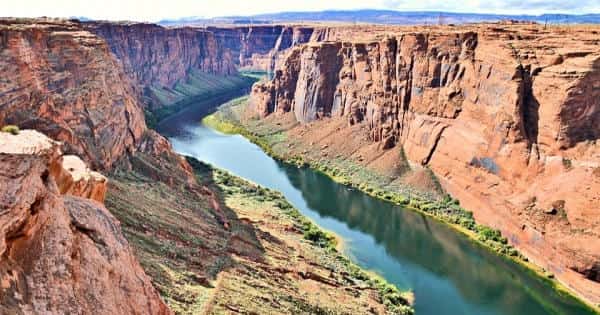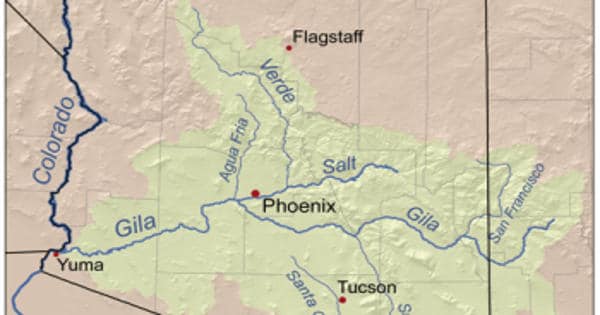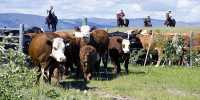Climate change is driving extreme, interconnected events among earth-system elements such as weather and water in the vast Colorado River basin. According to new research, these events are becoming more frequent and intense, and they are best studied together rather than separately.
“We discovered that concurrent extreme hydroclimate events, such as high temperatures and unseasonable rain that rapidly melt mountain snowpack and cause downstream floods, are projected to increase and intensify within several critical regions of the Colorado River basin,” said Katrina Bennett, a hydrologist at Los Alamos National Laboratory and lead author of the paper published in the journal Water. “Concurrent extreme events of multiple types, rather than isolated events of a single type, will actually harm people, society, and the economy.”
Another example of concurrent hydroclimate events is low precipitation combined with high temperatures, which results in drought. Other factors that contribute to impacts include low soil moisture and wildfire burn scars on steep slopes.
“We found that concurrent extreme hydroclimate events, such as high temperatures and unseasonable rain that quickly melt mountain snowpack to cause downstream floods, are projected to increase and intensify within several critical regions of the Colorado River basin,” said Katrina Bennett.
Excessive hydrological/climatological events in the Colorado River basin must be studied collectively, not in isolation, to get a clearer picture of their devastating effects in the coming years. Local weather change is causing extreme, interconnected events among earth-system components such as climate and water in the massive Colorado River basin. According to new research, these events have become more frequent and intense, and they are best studied collectively rather than in isolation.
“It’s never just a big rain event that causes a big flood,” Bennett said. “It is the result of a combination of factors, including fire, topography, and whether the summer was wet or dry. That is how we should begin to think about these events.”
The Los Alamos study examined heat waves, drought, flooding, and low flows in six earth-system models for the entire Colorado River basin. Wyoming, Colorado, New Mexico, Utah, Nevada, Arizona, and California are all part of the basin.
The models were run for a historical period (1970-1999) and a projected future period using indicators such as maximum temperature, maximum precipitation, dry days, maximum and minimum streamflow, maximum and minimum soil moisture, and maximum evapotranspiration (2070-2099). They looked at the difference between two periods (future minus historical) for events on four different time scales: daily, monthly, seasonal, and annual.

Overall, precipitation increased by 2.1 millimeters in Colorado between the future and historical periods, with some models showing increases and others showing decreases. Nonetheless, the team discovered that precipitation changes caused an increase in concurrent extreme events in all cases.
Temperature, unsurprisingly, increased across all six models and was an even stronger catalyst of events. The study discovered an average temperature rise of 5.5 degrees Celsius between the future and historical periods across the entire basin.
In all scenarios, the number and magnitude of each type of extreme event increased on average across the Colorado River Basin in the future compared to the historical period. These figures were provided as a statistical representation of the change in frequency between the historical and future periods, rather than as a count of discrete events.
These increases have far-reaching social, economic, and environmental consequences for the entire region, which serves as a major economic engine for the United States. The study identified four critical watersheds in the Colorado basin – the Blue River basin, Uncompahgre, East Taylor, and Salt/Verde watersheds – that are home to important water infrastructures, water resources, and hydrological research and are particularly vulnerable to future extreme events.
Water management and reservoir operations take place on a subannual time scale in many parts of the United States. These projects frequently have seasonal goals, such as flood control, recreation, and hydropower. As a result, information beyond a seasonal forecast is of little use for facilities with limited storage capacity. The Colorado River basin, on the other hand, has a collective storage capacity that is approximately four times the river’s mean annual flow. Furthermore, Lakes Powell and Mead alone contain more than 80% of that storage. Thus, understanding persistent modes of streamflow variability at the interannual and longer time scale is of great importance for water management in this system.
According to 2014 figures, more than 40 million people rely on the Colorado River basin for water, and it directly supports $1.4 trillion in agricultural and commercial activity – roughly one-thirteenth of the US economy.
Flooding, drought, freezing events, wildfire, severe storms, and winter storms cost approximately $40 billion in Utah, Colorado, Arizona, and New Mexico between 1980 and 2020. This research was supported by the Los Alamos National Laboratory’s Early Career Laboratory Directed Research and Development (LDRD) program.













